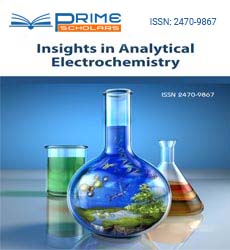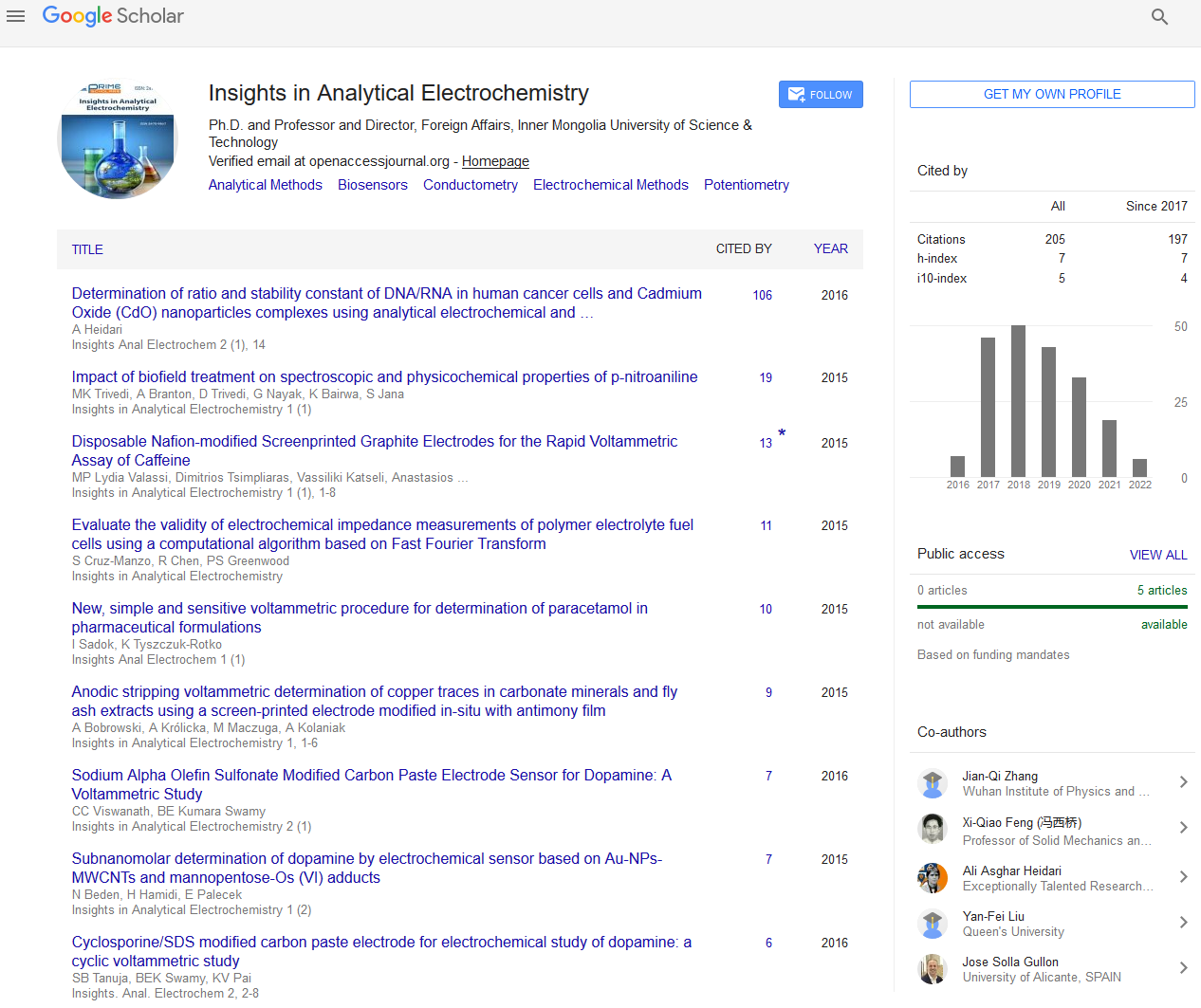Short Communication - (2022) Volume 8, Issue 5
Impact of Electro Analytical Chemistry in Chemical Analysis.
Suresh Kailasa*
Department of Chemistry, Sardar Vallabhbhai National Institute of Technology, India
*Correspondence:
Suresh Kailasa,
Department of Chemistry, Sardar Vallabhbhai National Institute of Technology,
India,
Email:
Received: 31-Aug-2022, Manuscript No. IPAEI-22-14739;
Editor assigned: 02-Sep-2022, Pre QC No. IPAEI-22-14739 (PQ);
Reviewed: 16-Sep-2022, QC No. IPAEI-22-14739;
Revised: 21-Sep-2022, Manuscript No. IPAEI-22-14739 (R);
Published:
28-Sep-2022, DOI: 10.21767/2470-9867.22.8.21
INTRODUCTION
Analytical chemistry consists of methods for determining the
chemical composition of the analyses. A qualitative method
gives information about the atomic or molecular species or
the functional groups that exist in the sample; a determination
method, notwithstanding, provides numerical information as
to the relative amount of one or more of these components.
Sensitive, accurate, and precise methods are desired. Titrimetric,
absorption, emission spectroscopy, thermal, and electro
analytical methods are used for the determination of analyses
from a matrix with very low detection limits. Electro analysis
is an covering all branches of electro analytical chemistry, including
both fundamental and application papers as well as
reviews dealing with new electrochemical sensors and biosensors,
Nano bioelectronics devices, analytical voltammetry,
potentiometric, new electrochemical detection schemes based
on novel nanomaterials, fuel cells and biofuel cells, and important
practical applications.
Description
Serving as a vital communication link between the research labs
and the field, Electro analysis helps you to quickly adapt the latest
innovations into practical clinical, environmental, food analysis,
industrial and energy-related applications. Electro analysis
provides the most comprehensive coverage of the field and is
the number one source for information on electro analytical
chemistry, electrochemical sensors and biosensors and fuel/
biofuel cells. Voltammetry is a technique in which the potential
is varied in a regular manner while the current is monitored.
Polarography is a subtype of voltammetry that utilizes a liquid
metal electrode. Coulometer is a method that monitors the
quantity of electricity (coulombs) that are consumed during
an electrochemical reaction involving the analyse. The second
major category of instrumental analysis is electro analysis. The electro analytical methods use electrically conductive probes,
called electrodes, to make electrical contact with the analyse
solution. The electrodes are used in conjunction with electric
or electronic devices to which they are attached to measure an
electrical parameter of the solution. The measured parameter
is related to the identity of the analyse or to the quantity of the
analyse in the solution. Amperometry monitors electric current
(amperes) while keeping the potential constant. Conductometry
measures conductance (the ability of a solution to carry
an electric current) while a constant alternating-current (AC)
potential is maintained between the electrodes. Electrogravimetry
is a gravimetric technique similar to the classical gravimetric
methods that were described above, in which the solid that
is weighed is deposited on one of the electrodes. The electro
analytical methods are divided into categories according to the
electric parameters that are measured.
Conclusion
The major electro analytical methods include potentiometric,
amperometry, conductometry, electrogravimetry, voltammetry
(and polarography), and coulometry. The names of the
methods reflect the measured electric property or its units.
Potentiometry measures electric potential (or voltage) while
maintaining a constant (normally nearly zero) electric current
between the electrodes. Amperometry indicates the whole of
electrochemical techniques in which a current is measured as
a function of an independent variable that is, typically, time or
electrode potential. Chronoamperometry is the technique in
which the current is measured, at a fixed potential, at different
times since the start of polarisation. Chronoamperometry is
typically carried out in unstirred solution and at the fixed electrode,
i.e., under experimental conditions avoiding convection
as the mass transfer to the electrode. On the other hand, voltammetry
is a subclass of amperometry, in which the current
is measured by varying the potential applied to the electrode. According to the waveform that describes the way how the potential
is varied as a function of time, the different voltammetry
techniques are defined.
Acknowledgement
None.
Conflict of Interest
The author’s declared that they have no conflict of interest.
REFERENCES
- Piliang H, Sunil S, Adav D (2017) Recent advances in mass spectrometric analysis of protein deamidation. Mass Spectrom Rev 36(6): 677–692.
[Crossref] [Google Scholar] [PubMed]
- Noyhouzer T, Valdinger I, Mandler D (2013) Enhanced potentiometry by metallic nanoparticles. Anal Chem 85(17): 8347–8353.
[Crossref] [Google Scholar] [PubMed]
- Sun J, Geng Z, Xue N (2018) A mini-system integrated with metal-oxide-semiconductor sensor and micro-packed gas chromatographic column. Micromachines. 9(8): 408.
[Crossref] [Google Scholar] [PubMed]
- Hurtado M, Davidson JL, Blyth CA, Lowe J (2010) Holographic detection of hydrocarbon gases and other volatile organic compounds. Langmuir. 26(19): 15694–9.
[Crossref] [Google Scholar] [PubMed]
Citation: Kailasa S (2022) Impact of Electro Analytical Chemistry in Chemical Analysis. Insights Anal Electrochem. 8:21.
Copyright: © 2022 Kailasa S. This is an open-access article distributed under the terms of the Creative Commons Attribution
License, which permits unrestricted use, distribution, and reproduction in any medium, provided the original author and source
are credited.

